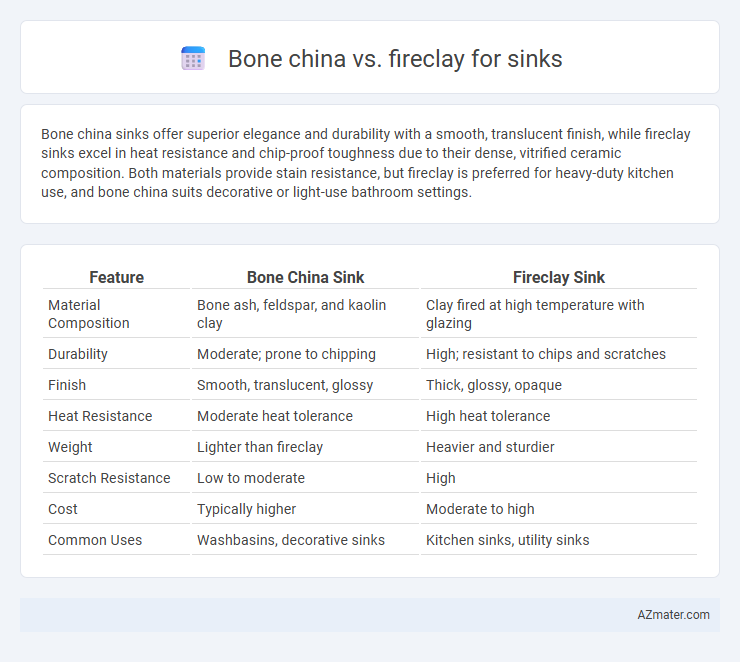Bone china sinks offer superior elegance and durability with a smooth, translucent finish, while fireclay sinks excel in heat resistance and chip-proof toughness due to their dense, vitrified ceramic composition. Both materials provide stain resistance, but fireclay is preferred for heavy-duty kitchen use, and bone china suits decorative or light-use bathroom settings.
Table of Comparison
| Feature | Bone China Sink | Fireclay Sink |
|---|---|---|
| Material Composition | Bone ash, feldspar, and kaolin clay | Clay fired at high temperature with glazing |
| Durability | Moderate; prone to chipping | High; resistant to chips and scratches |
| Finish | Smooth, translucent, glossy | Thick, glossy, opaque |
| Heat Resistance | Moderate heat tolerance | High heat tolerance |
| Weight | Lighter than fireclay | Heavier and sturdier |
| Scratch Resistance | Low to moderate | High |
| Cost | Typically higher | Moderate to high |
| Common Uses | Washbasins, decorative sinks | Kitchen sinks, utility sinks |
Introduction: Bone China vs Fireclay Sinks
Bone china sinks offer exceptional durability and a smooth, glossy finish that resists staining and chipping, making them ideal for elegant kitchen designs. Fireclay sinks are crafted from molded clay and glaze, providing robust impact resistance and a rustic, traditional appearance favored in farmhouse-style kitchens. Both materials combine strength and aesthetic appeal, but bone china delivers a finer, more delicate look while fireclay emphasizes sturdiness and heat resistance.
Material Composition and Properties
Bone china sinks are crafted from a mixture of bone ash, feldspar, and kaolin, resulting in a lightweight yet durable ceramic with a translucent, smooth finish resistant to chipping and cracking. Fireclay sinks consist of a dense, vitreous ceramic made by firing clay at extremely high temperatures, producing a non-porous, heat-resistant surface that is highly durable and scratch-resistant. The bone china's calcium phosphate content provides enhanced strength and translucency, while fireclay's vitrification process creates a harder, more stain-resistant material ideal for heavy-duty use.
Manufacturing Processes Explained
Bone china sinks are crafted using a mixture of bone ash, kaolin, and feldspar, which is molded and fired at extremely high temperatures to achieve a translucent, durable finish with a smooth texture. Fireclay sinks are created by molding clay mixed with minerals, then firing it at temperatures typically between 1,200degC to 1,300degC, resulting in a dense, non-porous surface with exceptional strength and resistance to chipping. The manufacturing process of bone china emphasizes translucency and fine detail, while fireclay focuses on robustness and thermal shock resistance due to its vitrified ceramic composition.
Aesthetic Appeal and Design Options
Bone china sinks offer a smooth, glossy finish with a translucent quality that enhances bright, elegant bathroom designs, while fireclay sinks provide a matte or semi-gloss finish known for durability and rustic charm. Bone china's delicate appearance supports sophisticated, high-end aesthetics, often available in classic white and subtle hues, whereas fireclay sinks come in a wider variety of colors and shapes, catering to farmhouse or vintage-inspired interiors. Both materials complement distinct design preferences, with bone china excelling in refined elegance and fireclay in robust, versatile styling.
Durability and Longevity Comparison
Bone china sinks offer moderate durability with a smooth, non-porous surface that resists stains and chipping but may chip or crack under heavy impact. Fireclay sinks provide superior durability due to their thick, vitrified clay composition fired at extremely high temperatures, resulting in exceptional resistance to scratching, chipping, and thermal shock. Longevity of fireclay sinks typically surpasses bone china, maintaining an intact and glossy appearance over decades of heavy use in kitchens and bathrooms.
Maintenance and Cleaning Requirements
Bone china sinks require gentle cleaning with non-abrasive cleaners and soft cloths to preserve their delicate glaze and prevent chipping. Fireclay sinks are more durable and resistant to scratches and stains, allowing for easier maintenance with mild detergents and regular wiping. Both materials benefit from avoiding harsh chemicals and abrasive scrubbing to maintain their finish and longevity.
Stain and Scratch Resistance
Fireclay sinks offer superior stain and scratch resistance compared to bone china, largely due to their dense, vitrified surface that withstands heavy daily use in kitchens. Bone china, although elegant and smooth, tends to be more prone to staining from acidic substances and minor scratches from utensils. Choosing fireclay provides enhanced durability and easier maintenance, especially in high-traffic or professional cooking environments where resistance to wear is crucial.
Cost Differences and Value for Money
Bone china sinks typically cost more due to their refined composition of bone ash, which offers a glossy finish and enhanced durability, making them a premium choice for kitchens and bathrooms. Fireclay sinks are priced moderately lower, benefiting from a dense ceramic material that resists chipping and staining, providing longevity at a more affordable rate. When considering value for money, fireclay balances durability and cost effectively, while bone china delivers superior aesthetic appeal and smoothness but at a higher investment.
Environmental Impact and Sustainability
Bone china sinks, made from refined clay mixed with bone ash, offer durability but have a higher carbon footprint due to the energy-intensive firing process and sourcing of animal-derived materials. Fireclay sinks are crafted from natural clay and minerals fired at extremely high temperatures, resulting in a highly durable, non-toxic product with lower environmental impact since they typically use abundant raw materials and have longer lifespans. Both materials are recyclable, but fireclay's natural composition and fewer processing steps generally make it a more sustainable choice with reduced ecological footprint.
Choosing the Right Sink: Key Takeaways
Bone china sinks offer exceptional durability and a smooth, glossy finish that resists chipping, making them ideal for kitchens prioritizing elegance and longevity. Fireclay sinks excel in heat and stain resistance due to their vitrified ceramic composition, providing a robust choice for high-traffic kitchens with frequent use. When choosing the right sink, consider bone china for aesthetic appeal and fireclay for practical durability and easy maintenance.

Infographic: Bone china vs Fireclay for Sink
 azmater.com
azmater.com